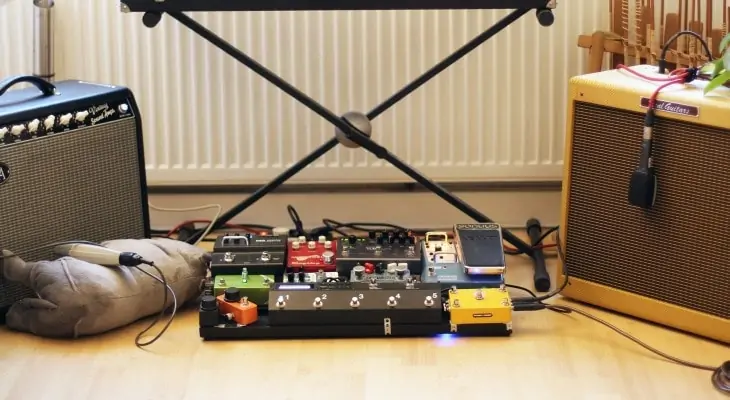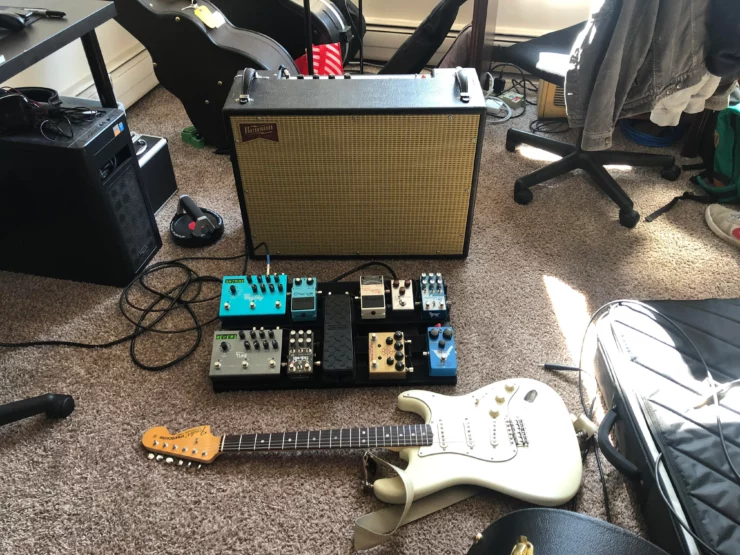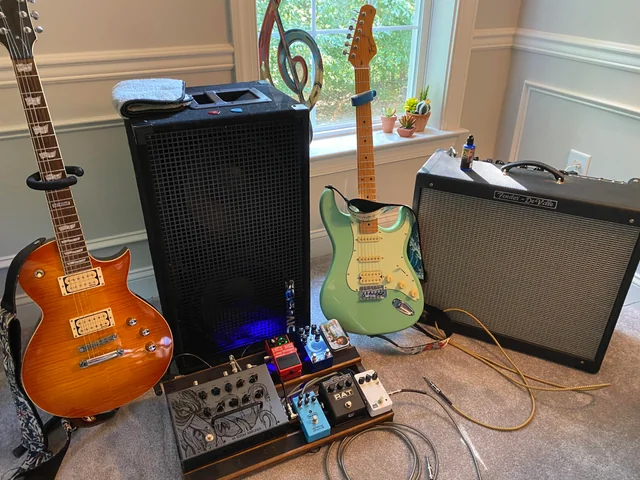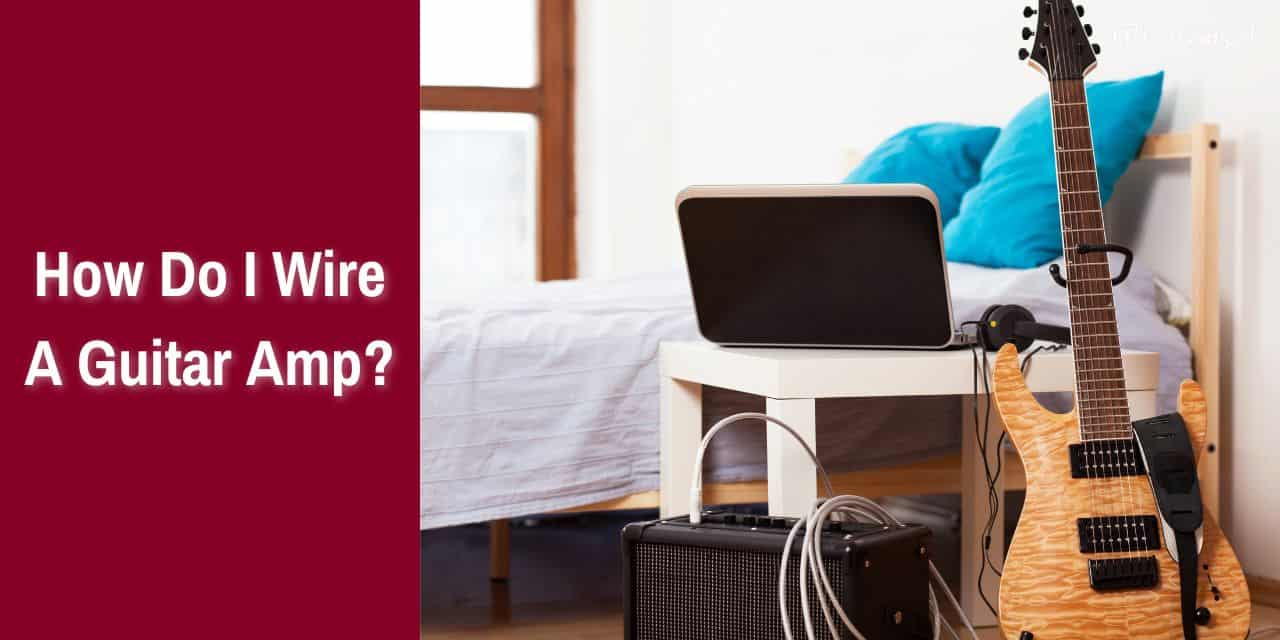Are you a guitar player looking to understand how to wire your guitar amp? Knowing how to correctly wire a guitar amp is an essential skill for all guitar players. In this article, we will provide a step-by-step guide to help you wire your guitar amp correctly, so you can be sure your guitar sounds as great as it should. Read on to learn more and get ready to take your guitar playing to the next level!
What is wiring in guitar amps?
When it comes to electric guitars and amps, there is a lot more than what meets the eye. Behind the sleek exterior and powerful sound lies a complex system of wiring that plays a key role in shaping the tone and functionality of the amp.
Wiring in guitar amps refers to the intricate network of electrical connections and components that transmit the signal from the guitar to the amp and eventually produce sound. It involves a combo of cables, connectors, circuit boards, resistors, transformers, capacitors, and other electronic elements that work together, amplify the signal, and shape the tone.
>>> Click here to read our review about the Top 15 Best Guitar Amps <<<
At its core, the wiring of a guitar amp facilitates the signal path from the input jack to the speaker. The signal from the guitar is received first through the input jack, where it enters the amp’s circuitry. From there, the signal is processed, amplified, and shaped through various stages, including preamp, tone controls, effects loops, power amp, and output transformer.
Each stage of the circuitry relies on precise wiring to ensure that the signal is properly transmitted, amplified, and delivered to the speaker without loss or interference. The quality and integrity of the wiring connections directly impact the overall sound quality, tonal characteristics, and performance of the amp.
The wiring in a guitar amp also plays a major role in shaping the tonal characteristics of the amplifier. Different configurations of wiring, component choices, and signal paths can have a huge effect on the frequency response, gain structure, dynamics, and overall tonal balance. For instance, the choice of wiring in the preamp section will determine the amount of gain and distortion. Meanwhile, the wiring in the tonal control section can greatly shape the EQ response and tonal shaping capabilities. Even the quality of the wiring and the materials used will impact factors such as noise levels, signal clarity, and signal-to-noise ratio.
Reliable and well-executing wiring will be important for the longevity and durability of a guitar amp. Properly soldered connections, secure wiring routing, and high-quality components will contribute to the overall reliability and stability of the guitar amp. Moreover, well-organized wiring makes it much easier to troubleshoot and maintain the guitar amp. Clear labeling, proper grounding, and logical wiring layout facilitate efficient troubleshooting and repairs, ensuring that any faults can be addressed promptly without compromising the overall performance of the guitar amp.
The wiring in guitar amps will also allow for customization and modifications, providing opportunities for guitarists and technicians to tailor the guitar amp’s sound to their preferences. By properly understanding the wiring scheme and circuitry, experienced individuals will be able to modify or replace components, experiment with different wiring configurations, or even design entirely new circuits to achieve specific tonal characteristics or add unique features.

How do I wire a guitar amp?
Wiring a guitar amp might seem like a slightly daunting task, especially if you are a beginner or novice. However, with the right knowledge and a systematic approach, it can end up being a fairly easy and extremely rewarding process. Here are the steps you will need to follow if you’re unsure about how do I wire a guitar amp in my guitar setup. By following these steps, you will be able to gain a better understanding of the inner workings of your guitar amp and have the satisfaction of building your own musical instrument.
Step 1: Prepare the guitar amp
Before you can start the wiring process, it will be important to prepare the guitar amp and gather the necessary tools and equipment. You will need to carry out a series of preparatory steps like gathering the tools, familiarizing yourself with the amp, and more.
First, you will need to gather the required tools, including screwdrivers, wire cutters, wire strippers, solder, soldering iron, and any additional components required for the wiring process.
You should also familiarize yourself with the guitar amp’s owner’s manual for your amp model. This will give you the essential information needed about the wiring scheme, components, and any specific instructions or precautions.
Safety must always be a priority. You need to ensure that the guitar amp is unplugged from the power source and that you’re in a well-lit and properly grounded work area.
Step 2: Connect the components
Once you have prepared the amp, the next thing to do will be to connect the components. Here, you will need to perform steps like planning the wiring layout, soldering the connections, organizing the wiring, and more.
Start by reviewing the wiring diagram provided in the owner’s manual or create a custom diagram for modification. Now, properly plan out the layout of the components, taking note of the signal flow and any specific wiring instructions.
Using the wire cutters and strippers, you should carefully strip the appropriate lengths of wire insulation. Solder the connections while making sure that the wires are securely fastened. Be mindful of proper polarity and grounding as these factors will be important for proper operation and safety.
Then, you should neatly organize the wiring, using zip ties or wire clips to secure the cables and prevent them from interfering with other components or moving parts. Proper cable management will make future maintenance and troubleshooting much easier.
Lastly, you will need to connect the input and output jacks, following the wiring diagram you drew or the instructions provided. Double-check the connections to make sure that they are secure and correctly wired.

Step 3: Test the wiring
Once you have connected the components, it will be important to test the wiring to make sure it has proper functionality. Start by inspecting connections. Conduct a visual inspection of the wiring connections, checking for loose or soldered connections, any misplaced wires, or any potential issues. Plug the guitar amp into a power source, following the safety precautions outlined in the owner’s manual. Make sure that the power switch is in the off position.
Try performing the basic functionality test and observe the results. Turn on the guitar amp and test basic functionality, such as sound output, control responsiveness, and other features specific to your guitar amp. Pay attention to any abnormal sounds or erratic behavior.
You should also check for grounding issues. Use a multimeter or continuity tester to check for proper grounding. Make sure that all the grounded components and connections have continuity and that there are no unexpected shorts or open circuits.
If any issues arise during testing, consult the owner’s manual or seek guidance from experienced technicians. Fine-tune the controls or settings as needed to achieve the desired sound.
Different types of wiring in guitar amps
The wiring configuration of a guitar amp plays a key role in shaping its overall sound and functionality. Understanding the different types of wiring is important for musicians and amp enthusiasts looking to customize or modify their amp’s performance. Here are the common wiring configurations in guitar amps and their distinct characteristics.
Series wiring
Series wiring is a common configuration often used in guitar amp circuits. In this setup, the components like speakers or pickups are connected in a linear chain, creating a single path for the electrical current to flow. For series wiring, you will need to know a thing or two about electrical flow, output, tone, and more.
In series wiring, the electrical current passes through each component consequently, maintaining the same current flow throughout the circuit. This configuration adds the impedance values of each component, resulting in a higher overall impedance.
Series wiring can often result in a higher total impedance, which affects the overall output level and tonal characteristics of the amp. It tends to provide a smoother and more focused sound, with enhanced midrange response and increased overall resistance to speaker damping.
Series wiring might limit the power handling capability of the speakers as the overall impedance increases with each added speaker. It is important to consider the power ratings and compatibility of the components to avoid overloading the guitar amp.
Parallel wiring
Parallel wiring typically involves connecting components side by side, creating multiple paths for electrical current to flow simultaneously. Here are the different key aspects of parallel wiring that you need to consider.
In parallel wiring, each component will receive the full voltage from the amp while the current is divided among the connected components. This configuration maintains a consistent voltage across each component.
Parallel wiring lowers the overall impedance, increasing the power handling capabilities of the speakers, and potentially producing a louder output. It tends to provide wider frequency response, improved dynamic range, and enhanced speaker damping.
It is important to make sure that the amp can handle the lower total impedance resulting from parallel wiring. Careful consideration of power ratings and component compatibility will be crucial for preventing overloading or damaging the amp.

Speaker-parallel wiring
Series-parallel wiring combines the best elements of both series and parallel wiring configurations, offering a flexible approach to achieving specific tonal characteristics. Here is what you need to know about series-parallel wiring in a guitar amp.
In a series-parallel wiring, speakers or other components will be grouped into series pairs and these parallel pairs will then be connected in parallel. This configuration will allow for a balance between impedance control and power handling.
Series-parallel wiring will provide a compromise between the tonal characteristics of series and parallel wiring. It will allow for increased power handling compared to series wiring while also offering some of the tonal benefits of parallel wirings, such as speaker damping and improved dynamics.
This type of wiring also provides greater flexibility in achieving specific impedance and tonal requirements. By carefully configuring the series and parallel connections, musicians and amp enthusiasts will be able to tailor the output, tonal response, and overall performance of the amp to their preferences.
Tips for wiring a guitar amp
Wiring a guitar will involve technical knowledge, careful consideration of the components used, attention to detail, and a solid understanding of electrical connections. Whether you are building a guitar amp from scratch or modifying an existing one, there are certain guidelines and tips that you can follow and greatly enhance your wiring experience and ensure optimal performance. By selecting the right components and using the right techniques, you will be able to ensure a successful and efficient wiring job to enhance the performance and reliability of the guitar amp. Here are the important tips you need to follow for choosing the right components and achieving the desired sound from your guitar amp.
#1. Plan and draw out the wiring layout
Before you start the wiring process for your guitar amp, take the time to plan and diagram the wiring layout. This step will help you visualize the connections, identify the potential issues in advance, and ensure a logical and efficient wiring scheme. You must consider the signal flow, grounding requirements, and component placement. Create a well-drawn and detailed diagram that you can refer to throughout the wiring process.
#2. Choose the right components
Before you select the components, conduct thorough research and understand the specifications, characteristics, and compatibility requirements. You should consider factors like impedance ratings, power handling capabilities, and voltage requirements. Make sure that the chosen components are suitable for your guitar amp model and intended application.
Always go for components only from reputable manufacturers. Well-constructed components will not only contribute to better sound quality but will also offer improved reliability and longevity. You should look for components that have been tested and reviewed positively by professionals and enthusiasts.
When selecting components such as pickups or speakers, you should aim for a well-matched combination. Matching components will ensure optimal performance and compatibility, resulting in a balanced and cohesive sound. You need to consult manufacturer guidelines, recommendations, and user forums for insights on suitable component pairings.
You must also consider the level of customization you desire for your guitar amp. Some components, such as potentiometers, capacitors, and transformers, offer different values or characteristics that can alter the tonal response and functionality. You need to understand how these components will affect your guitar amp’s sound and explore options that align with your preferences.
#3. Use the right tools
Gather the needed tools before you can start the wiring process. Basic tools include wire cutters, soldering iron, wire strippers, solder, multimeter, screwdrivers, continuity tester, and heat shrink tubing. These tools will allow you to handle different wiring tasks efficiently and ensure reliable connections.
Make sure that you invest in a high-quality soldering iron and use the appropriate solder for the task. A temperature-controlled soldering iron with a fine tip will offer precise control over the soldering process. Clean and properly tin the soldering iron tip before each use for optimal heat transfer and reliable solder joints.
Proper wire management will be important for the neatness, organization, and maintenance of your guitar amp. Use cable ties, wire clips, and cable organizers to secure and route the wires cleanly. This will not only improve the aesthetics but also prevents interference or accidental damage to the wires or components.
You need to prioritize safety throughout the wiring process. Make sure that the guitar amp is unplugged from the power source and that you are in a well-ventilated area. Wear appropriate safety equipment, including safety glasses and heat-resistant gloves when handling hot components. Double-check the connections and wiring polarity to avoid short circuits or electrical hazards.
After wiring the guitar amp, use a multimeter or continuity tester for verifying the connections, check for proper grounding, and ensure that there are no shorts or open circuits. This step is important for identifying potential issues and fine-tuning the amp’s performance.
#4. Use high-quality wiring
Invest in high-quality wiring and components for your guitar amp. The quality of wiring and components can greatly affect the overall sound quality, reliability, and longevity of the amp. Choose solid core or stranded wire with appropriate gauge ratings for the different connections. Go for reputable and reliable brands for capacitors, resistors, potentiometers, and other components to ensure optimal performance.
#5. Practice proper soldering techniques
Soldering is an important aspect of wiring in a guitar amp. Proper soldering techniques will ensure reliable connections and minimize the risk of cold solder joints or electrical shorts. Here are the tips you need to consider for practicing proper soldering –
- Use a soldering iron with an appropriate wattage for the task
- Clean and tin the soldering iron tip before each solder joint
- Heat the wire/compound and apply solder directly to the joint, making sure that it flows evenly and creates a solid connection
- Avoid excessive solder and ensure that the joint is smooth, shiny, and free from blobs or rough surfaces
- Use heat shrink tubing or electrical tape to insulate and protect soldered connections
#6. Implement proper grounding techniques
Proper grounding will be important for reducing noise, hum, and potential electrical hazards in your guitar amp. Here are the grounding tips that you must keep in mind –
- Establish a solid and dedicated ground point for all ground connections
- Make use of dedicated ground wires for different components and avoid sharing grounding paths
- Connect the chassis of the guitar amp to the dedicated ground point
- Make sure that all grounding connections are secure and free from any loose connections or corrosion
- Separate audio and power ground paths to minimize potential interference
#7. Organize and label the wiring
Organizing and labeling the wiring will be important for future maintenance, troubleshooting, and modifications. Make use of zip ties, wire clips, or cable organizers to keep the wiring neat and organized. Label the connections or use color coding for easy identification. This practice will save you time and effort when you have to trace or modify specific connections.
#8. Test and debug
After completing the wiring, perform thorough testing and debugging to make sure you get proper functionality. Use a multimeter or continuity tester to check for proper continuity, grounding, and any potential shorts or open circuits. Verify that the signal flow is as intended and that all the components are operating correctly. Address any issues promptly to avoid further complications.
FAQs
What is the general process for wiring a guitar amp?
Wiring a guitar amp typically involves connecting the power supply, speakers, and the amp head to create a complete circuit. The power supply is usually connected to the amp head and speakers, and the amp head is then connected to the speakers. It is important to make sure the wiring is done correctly and safely, so it is recommended to consult the manual for specific instructions on how to wire your particular amp.
What tools are needed to wire a guitar amp?
When wiring a guitar amp, it is important to have the right tools. This typically includes a soldering iron, solder, and wire cutters, as well as the necessary cables and connectors. Additionally, you may need an amplifier wiring kit, which includes the various components needed to safely and correctly wire your amp.
What safety precautions should I take when wiring an amp?
When wiring an amp, it is important to take safety precautions to prevent electric shock or damage to your equipment. Make sure to disconnect the power before beginning any wiring, and follow the instructions in your manual carefully. Additionally, make sure to wear protective gloves and eyewear, and make sure that all connections are secure and insulated.



